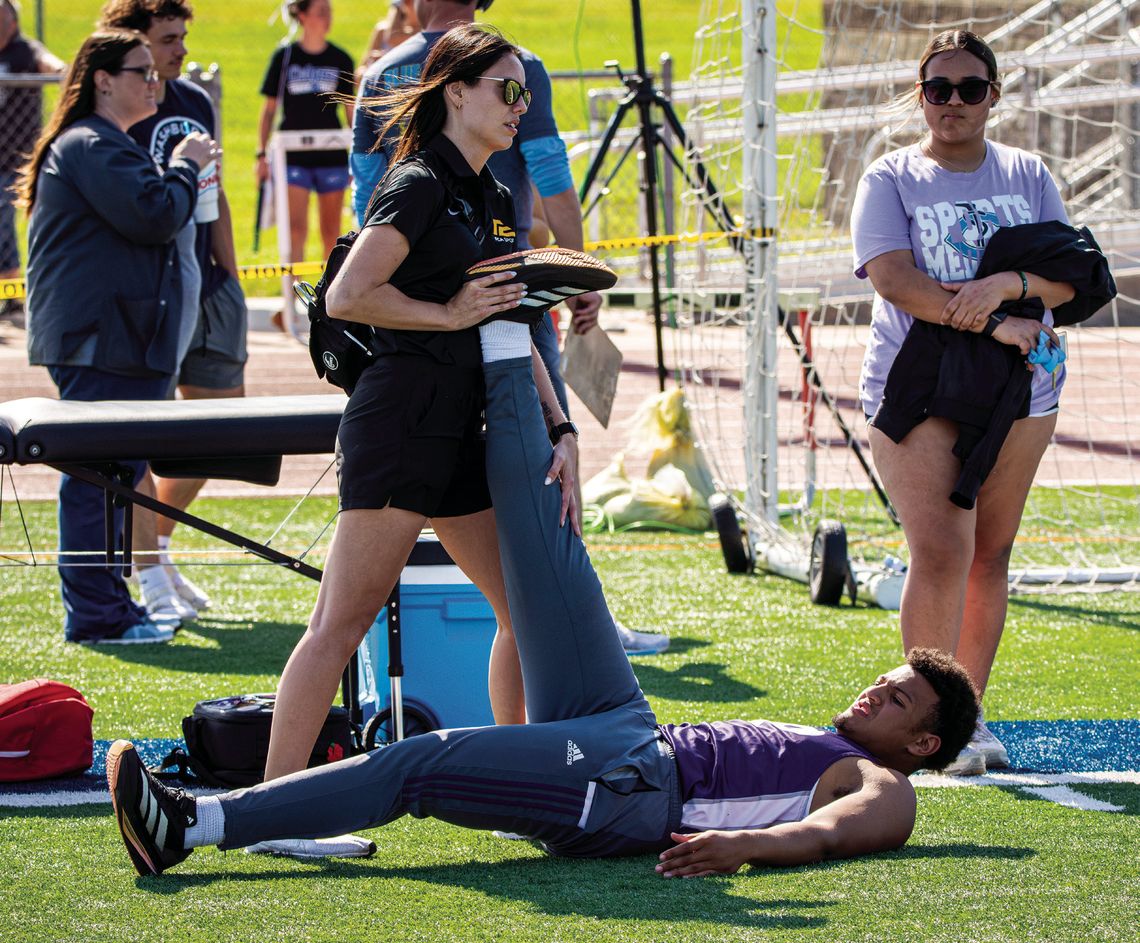Burnout among high school athletes is pervasive. KSHSAA has its sights on addressing it in Kansas.
In a newsletter penned by KSHSAA Executive Director Bill Faflick last week, he cited three trends: — Half of high school athletes report injuries sustained in training that contribute to mental and physical exhaustion.
— 36% of high school athletes report burnout stemming from pressure from coaches and parents.
— 70% of kids drop out of organized sports by age 13.
“We want parents and kids and coaches to understand that sometimes boundaries are good,” Faflick said. “When you step over those, what happens? Injuries and potential burnout. One of the most compelling things is the number of kids that don’t participate in a sport all the way through high school that they used to love. We have kids that peak in their freshman and sophomore years rather than getting better and better.”
As training regimens have saturated the calendar, Aaliyah Manuz, the athletic trainer at Chanute High School, says she treats overuse injuries more frequently.
“Kids aren’t getting time off so I’m seeing it more,” Manuz said. “They never get true rest. They do stuff on the weekends. I don’t think coaches prioritize rest as much as we should. When kids have a strain, coaches want me to fix them in one day. Players in the NBA will get a strain and they’ll miss two weeks. But we want these kids at the high school level to just tough it out.”
In addition to the frenetic pace of athletics during the school year, KSHSAA allows schools to hold workouts with athletes during the entire month of June.
After a one-week moratorium that covers the Fourth of July, schools continue workouts for the rest of July until it’s scaled to just weights and conditioning in August.
Faflick trained his crosshairs on the summer schedule in his newsletter.
“As we prepare for summer, which has been transformed from an opportunity for students and coaches to recharge,” Faflick wrote, “into a fight for more training and more competition. Is it too much?”
Brainstorming cuts to the summer schedule has been a part of KSHSAA’s agenda for several years.
“We went to our membership a few years ago and rolled out a few options,” Faflick said. “Leave it as is, create windows of time in the summer for different sports…so kids weren’t getting tugged in different directions … and the third option was to give schools a certain number of days, 15 to 25, to limit the contact days. We rolled that out and did some straw polling and found we were pretty split. We didn’t have a majority amongst the three.”
Brent Unruh, the Director of Operations for KSHSAA, wants to see a dead week added after state track or at the end of July.
“One thing that’s been floated a little bit, and I like this for certain sports but not for others, but that first week after state track could be another dead week,” Unruh said. “I like that for fall and winter sports. But I feel differently for baseball and softball kids because the spring and summer are so different. That’s the only true chance they have for some development. But I’d also be in favor of having the last two weeks of July as a dead period. That gives families a chance to spend time together.”
Cutting time from the summer isn’t a one-size-fits-all solution for weary athletes.
“There’s so many different factors that are involved in this and there’s not one solution,” Unruh said. “Cutting down the summer schedule doesn’t fix the burnout issue. Everybody has to do their part in how they handle things.”
The emotional side
Psychological components of burnout are overlooked.
“It’s important for coaches to know the signs of burnout and be able to do things that can prevent it,” Manuz said. “A lot of burnout is more psychological. If we’re not mentally there, our bodies can’t do what they’re physically able to do.
“Getting a day off for mental health is still very stigmatized. Will kids get a day off from a coach if they just need a break? That’s still frowned upon a lot. Taking breaks gets stigmatized because they can’t see the sprain or the bruise.”
Kaia Simpson, a former NCAA softball pitcher at UC-San Diego, works for The Hidden Opponent, a non-profit focused on mental health in athletics.
“I was in severe, chronic pain. I could only throw a few innings and still be able to walk,” Simpson said. “I was really struggling. I felt hopeless on that front and I was doing everything I could. I was a human biology major so I struggled with studying because I couldn’t sit for a long time.”
Education on burnout is one of the pillars of The Hidden Opponent’s efforts.
“There’s a way to have a break without taking away opportunities to improve yourself,” Simpson said. “I always wanted to keep playing — I played with a travel team all summer long. But if I was hurting, there’s ways to do mental training that don’t put so much pressure on my body while still improving.”
Manuz believes coaches can be the first line of defense for athletes succumbing to burnout. “Coaches are around their athletes a lot so they should know more about personality changes,” Manuz said. “Performance is big as well. If they’re not performing normally, it may not be that they need more reps.”
Breaking the stigma
Any reduction in workouts would almost certainly have to come from KSHSAA — good luck convincing an athletic director or coach to willingly do less than their league rivals.
Last week’s newsletter was perhaps an opening salvo.
“Our goal this time of the year, and one of the strategies with sending out the email now, is that we know how busy the summer is,” Unruh said. “Everything is so crammed and kids are trying to satisfy the expectations of one or more sports. Changing the schedule might not be the answer. But we want to make sure the coaches recognize that they may need to maximize more time off.”
Unruh believes if athletes get more rest, and feel less burnout, the on-field product will improve.
“For coaches, if you want kids to be their best in their sport or whatever activity they’re involved in, rest and recovery is just as important, if not more, than some of the skill training,” Unruh said. “If you maximize rest and recovery, you’ll get the most out of them.”







